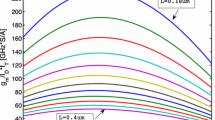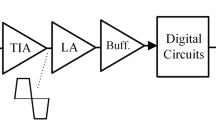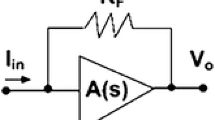Abstract
The inverter-based shunt-feedback transimpedance amplifier (TIA) has become an essential building block for high-speed receivers for optical interconnects in advanced technologies due to its low operating voltage and high efficiency. Previously, the design of TIA’s optimal noise is based on the relationship between the photodetector’s capacitance, \(C_{{\mathrm {D}}}\), and the TIA’s capacitance, \(C_{{\mathrm {I}}}\). In this paper, we present a method to calculate the accurate size of the inverter-based amplifier, feedback resistance \(R_F\), and load capacitance \(C_o\) for the optimal noise. Next, we further discuss the impact of the quality factor, channel length, and input parasitics on these parameters. Our analysis is applied to 65 nm CMOS technology based on MATLAB calculations. The predicted results agree well with the simulation results, offering valuable interpretations and conclusions that reveal the inherent tradeoffs among noise, data rate, and power consumption in the broadband optical TIA.










Similar content being viewed by others
References
Hazelwood, K., Bird, S., Brooks, D., Chintala, S., Diril, U., Dzhulgakov, D., Fawzy, M., Jia, B., Jia, Y., Kalro, A., Law, J., Lee, K., Lu, J., Noordhuis, P., Smelyanskiy, M., Xiong, L., & Wang, X. (2018). Applied machine learning at Facebook: a datacenter infrastructure perspective. In 2018 IEEE international symposium on high performance computer architecture (HPCA) (pp. 620–629).
Cisco Visual Networking. (2017). The zettabyte era-trends and analysis. Cisco white paper.
Cheng, Q., Bahadori, M., Glick, M., Rumley, S., & Bergman, K. (2018). Recent advances in optical technologies for data centers: A review. Optica, 5(11), 1354–1370.
Li, D., Minoia, G., Repossi, M., Baldi, D., Temporiti, E., Mazzanti, A., et al. (2014). A low-noise design technique for high-speed CMOS optical receivers. IEEE Journal of Solid-State Circuits, 49(6), 1437–1447.
Lakshmikumar, K., Kurylak, A., Nagaraju, M., Booth, R., & Pampanin, J. (2018.) A process and temperature insensitive CMOS linear TIA for 100 Gbps/\(\lambda\) PAM-4 optical links. In 2018 IEEE custom integrated circuits conference (CICC) (pp. 1–4).
Takemoto, T., Yamashita, H., Yazaki, T., Chujo, N., Lee, Y., & Matsuoka, Y. (2014). A 25-to-28 Gb/s high-sensitivity (\(-9.7\) dBm) 65 nm CMOS optical receiver for board-to-board interconnects. IEEE Journal of Solid-State Circuits, 49(10), 2259–2276.
Chen, Y., Kibune, M., Toda, A., Hayakawa, A., Akiyama, T., Sekiguchi, S., Ebe, H., Imaizumi, N., Akahoshi, T., Akiyama, S., Tanaka, S., Simoyama, T., Morito, K., Yamamoto, T., Mori, T., Koyanagi, Y., & Tamura, H. (2015). A 25 Gb/s hybrid integrated silicon photonic transceiver in 28 nm CMOS and SOI. In 2015 IEEE international solid-state circuits conference—(ISSCC) digest of technical papers (pp. 1–3).
Aoki, T., Sekiguchi, S., Simoyama, T., Tanaka, S., Nishizawa, M., Hatori, N., et al. (2018). Low-crosstalk simultaneous 16-channel \(\times\) 25 Gb/s operation of high-density silicon shotonics optical transceiver. Journal of Lightwave Technology, 36(5), 1262–1267.
Takemoto, T., Matsuoka, Y., Yamashita, H., Lee, Y., Arimoto, H., Kokubo, M., et al. (2018). A 50-Gb/s high-sensitivity (\(-9.2\) dBm) low-power (7.9 pJ/bit) optical receiver based on 0.18-\(\mu\)m SiGe BiCMOS technology. IEEE Journal of Solid-State Circuits, 53(3), 1518–1538.
Yu, K., Li, C., Li, H., Titriku, A., Shafik, A., Wang, B., et al. (2016). A 25 Gb/s hybrid-integrated silicon photonic source-synchronous receiver with microring wavelength stabilization. IEEE Journal of Solid-State Circuits, 36(9), 2129–2141.
Raj, M., Saeedi, S., & Emami, A. (2016). A wideband injection locked quadrature clock generation and distribution technique for an energy-proportional 16–32 Gb/s optical receiver in 28 nm FDSOI CMOS. IEEE Journal of Solid-State Circuits, 51(10), 2446–2462.
Ozkaya, I., Cevrero, A., Francese, P. A., Menolfi, C., Morf, T., Brändli, M., et al. (2017). A 64-gb/s 1.4-pj/b nrz optical receiver data-path in 14-nm cmos finfet. IEEE Journal of Solid-State Circuits, 52(12), 3458–3473.
Ahmed, M. G., Talegaonkar, M., Elkholy, A., Shu, G., Elmallah, A., Rylyakov, A., et al. (2018). A 12-Gb/s–16.8-dBm OMA sensitivity 23-mW optical receiver in 65-nm CMOS. IEEE Journal of Solid-State Circuits, 53(2), 445–457.
Huang, S., & Chen, W. (2017). A 25 Gb/s 1.13 pJ/b \(-10.8\) dBm input sensitivity optical receiver in 40 nm CMOS. IEEE Journal of Solid-State Circuits, 52(3), 747–756.
Sharif-Bakhtiar, A., & Carusone, A. C. (2016). A 20 Gb/s CMOS optical receiver with limited-bandwidth front end and local feedback IIR-DFE. IEEE Journal of Solid-State Circuits, 51(11), 2679–2689.
Nazari, M. H., & Emami-Neyestanak, A. (2013). A 24-Gb/s double-sampling receiver for ultra-low-power optical communication. IEEE Journal of Solid-State Circuits, 48(2), 344–357.
Saeedi, S., & Emami, A. (2014). A 25 Gb/s 170\(\mu\)W/Gb/s optical receiver in 28 nm CMOS for chip-to-chip optical communication. In 2014 IEEE radio frequency integrated circuits symposium (pp. 283–286).
Sackinger, E. (2012). On the noise optimum of FET broadband transimpedance amplifiers. IEEE Transactions on Circuits and Systems I: Regular Papers, 59(12), 2881–2889.
Li, J., Zheng, X., Krishnamoorthy, A. V., & Buckwalter, J. F. (2016). Scaling trends for picojoule-per-bit WDM photonic interconnects in CMOS SOI and FinFET processes. Journal of Lightwave Technology, 34(11), 2730–2742.
Ahmed, A. H., Sharkia, A., Casper, B., Mirabbasi, S., & Shekhar, S. (2016). Silicon-photonics microring links for datacenters—Challenges and opportunities. IEEE Journal of Selected Topics in Quantum Electronics, 22(6), 194–203.
Settaluri, K. T., Lalau-Keraly, C., Yablonovitch, E., & Stojanović, V. (2017). First principles optimization of opto-electronic communication links. IEEE Transactions on Circuits and Systems I: Regular Papers, 64(5), 1270–1283.
Bahadori, M., Rumley, S., Polster, R., Gazman, A., Traverso, M., Webster, M., et al. (2017). Energy-performance optimized design of silicon photonic interconnection networks for high-performance computing. Design, Automation Test in Europe Conference Exhibition, 2017, 326–331.
Polster, R., Thonnart, Y., Waltener, G., Gonzalez, J., & Cassan, E. (2016). Efficiency optimization of silicon photonic links in 65-nm CMOS and 28-nm FDSOI technology nodes. IEEE Transactions on Very Large Scale Integration (VLSI) Systems, 24(12), 3450–3459.
Liu, F. Y., Patil, D., Lexau, J., Amberg, P., Dayringer, M., Gainsley, J., et al. (2012). 10-Gbps, 5.3-mW optical transmitter and receiver circuits in 40-nm CMOS. IEEE Journal of Solid-State Circuits, 47(9), 2049–2067.
Smith, R. G., & Personick, S. D. (1980). Receiver design for optical fiber communication systems. In Topics in applied physics: Semiconductor devices for optical communication (vol. 39).
Abidi, A. A. (1984). Gigahertz transresistance amplifiers in fine line nmos. IEEE Journal of Solid-State Circuits, 19(6), 986–994.
Sackinger, E. (2005). Broadband circuits for optical fiber communication. Hoboken: Wiley.
Johns, D., & Martin, K. (1997). Analog integrated circuit design. New York: Wiley.
Razavi, B. (2012). Design of integrated circuits for optical communications. Hoboken: Wiley.
Sackinger, E. (2010). The transimpedance limit. IEEE Transactions on Circuits and Systems I: Regular Papers, 57(8), 1848–1856.
Sackinger, E. (2018). Analysis and design of transimpedance amplifiers for optical receivers. Hoboken: Wiley.
Morikuni, J. J., Dharchoudhury, A., Leblebici, Y., & Kang, S. M. (1994). Improvements to the standard theory for photoreceiver noise. Journal of Lightwave Technology, 12(7), 1174–1184.
Bahadori, M., Rumley, S., Polster, R., Gazman, A., Traverso, M., Webster, M., Patel, K., & Bergman, K. (2017). Energy-performance optimized design of silicon photonic interconnection networks for high-performance computing. In Design, automation test in Europe conference exhibition (DATE), 2017 (pp. 326–331).
Acknowledgements
The authors would like to thank Kadaba R. (Kumar) Lakshmikumar from Cisco Systems for technical discussions. The data, models or code generated during and analyzed during the current study are available from the corresponding author on reasonable request but can be subject to non-disclosure agreements with semiconductor foundries.
Author information
Authors and Affiliations
Corresponding author
Additional information
Publisher's Note
Springer Nature remains neutral with regard to jurisdictional claims in published maps and institutional affiliations.
This work is supported by U.S. Department of Energy Advanced Research Projects Agency Energy under ENLITENED Grant DE-AR0000843.
Appendix
Appendix
1.1 Derivation of transfer function
In Fig. 3, we use Kirchhoff’s laws to derive
where \(g_{{\mathrm {F}}} = 1/R_{{\mathrm {F}}}\) and \(g_{{\mathrm {o}}} = 1/R_{{\mathrm {o}}}\). (1) follows from (10).
We next explain the approximation of the first equation in (1). First, it is easy to understand \(A_0 R_{{\mathrm {F}}} \gg R_{{\mathrm {o}}}\), so we can omit the term \(R_{{\mathrm {o}}}\) in the numerator. Second, the zero from the numerator is located at
which is even higher than the CMOS transit frequency, \(f_{{\mathrm {T}}}\). As a result, the approximation is completely reasonable.
1.2 Derivation of input-referred noise current
First, we calculate the input-referred noise current density and derive (2). Second, we derive the total input-referred noise current through integral in (3).
To calculate the input-referred noise current density, we need to find the input-referred noise for noise sources \(\overline{i_{{\mathrm {n.res}}}^2}\) and \(\overline{i_{{\mathrm {n.D}}}^2}\), and they can be calculated through output noise. As shown in Fig. 11, let us calculate the output voltages \(v_{{\mathrm {o.a}}}\), \(v_{{\mathrm {o.b}}}\), and \(v_{{\mathrm {o.c}}}\) respectively. The admittance \(Y_{{\mathrm {F}}} = 1/Z_{{\mathrm {F}}}\) consists of the parallel of \(R_{{\mathrm {F}}}\) and \(C_{{\mathrm {F}}}\). The admittance \(Y_{{\mathrm {o}}} = 1/Z_{{\mathrm {o}}}\) consists of the parallel of \(R_{{\mathrm {o}}}\) and \(C_{{\mathrm {o}}}\).
From Fig. 11(a), Kirchhoff’s laws yield
Solving (12), we get
Similarly, from Fig. 11(b), Kirchhoff’s laws yield
and the solution is
From Fig. 11(c), Kirchhoff’s laws yield
and the solution is
With \(v_{{\mathrm {o.a}}} = v_{{\mathrm {o.b}}} = v_{{\mathrm {o.b}}}\) and \(Y_{{\mathrm {F}}} = sC_{{\mathrm {F}}} +1/R_{{\mathrm {F}}}\), we can get the ratio
To better understand the result, if we apply \(C_{{\mathrm {F}}} = 0\) and \(R_{{\mathrm {F}}} \gg R_{{\mathrm {o}}}\) to (18), we reach the same equation as in [31].
Now we derive the total input-referred noise current through integral.
Using the first equation in (1) without any approximation, we can get (3).
Rights and permissions
About this article
Cite this article
Zhang, Y., Kinget, P.R. The tradeoff between noise, data rate, and power consumption of transimpedance amplifiers for optical receivers. Analog Integr Circ Sig Process 108, 437–446 (2021). https://doi.org/10.1007/s10470-021-01895-y
Received:
Revised:
Accepted:
Published:
Issue Date:
DOI: https://doi.org/10.1007/s10470-021-01895-y





